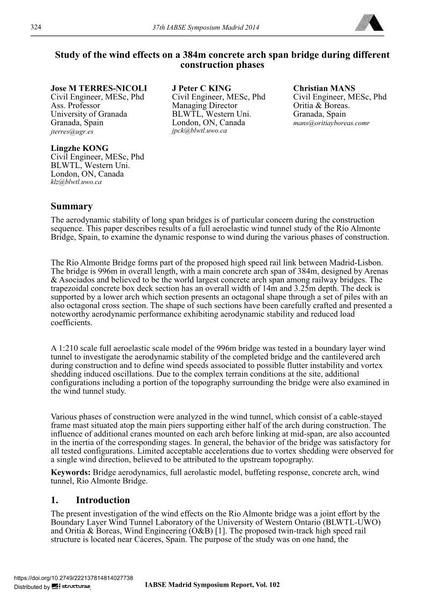Study of the wind effects on a 384m concrete arch span bridge during different construction phases

|
|
|||||||||||
Bibliografische Angaben
| Autor(en): |
Jose M. Terres-Nicoli
J. Peter C. King Christian Mans Lingzhe Kong |
||||
|---|---|---|---|---|---|
| Medium: | Tagungsbeitrag | ||||
| Sprache(n): | Englisch | ||||
| Tagung: | IABSE Symposium: Engineering for Progress, Nature and People, Madrid, Spain, 3-5 September 2014 | ||||
| Veröffentlicht in: | IABSE Symposium Madrid 2014 | ||||
|
|||||
| Seite(n): | 324-331 | ||||
| Anzahl der Seiten (im PDF): | 8 | ||||
| Jahr: | 2014 | ||||
| DOI: | 10.2749/222137814814027738 | ||||
| Abstrakt: |
The aerodynamic stability of long span bridges is of particular concern during the construction sequence. This paper describes results of a full aeroelastic wind tunnel study of the Río Almonte Bridge, Spain, to examine the dynamic response to wind during the various phases of construction. The Rio Almonte Bridge forms part of the proposed high speed rail link between Madrid-Lisbon. The bridge is 996m in overall length, with a main concrete arch span of 384m, designed by Arenas & Asociados and believed to be the world largest concrete arch span among railway bridges. The trapezoidal concrete box deck section has an overall width of 14m and 3.25m depth. The deck is supported by a lower arch which section presents an octagonal shape through a set of piles with an also octagonal cross section. The shape of such sections have been carefully crafted and presented a noteworthy aerodynamic performance exhibiting aerodynamic stability and reduced load coefficients. A 1:210 scale full aeroelastic scale model of the 996m bridge was tested in a boundary layer wind tunnel to investigate the aerodynamic stability of the completed bridge and the cantilevered arch during construction and to define wind speeds associated to possible flutter instability and vortex shedding induced oscillations. Due to the complex terrain conditions at the site, additional configurations including a portion of the topography surrounding the bridge were also examined in the wind tunnel study. Various phases of construction were analyzed in the wind tunnel, which consist of a cable-stayed frame mast situated atop the main piers supporting either half of the arch during construction. The influence of additional cranes mounted on each arch before linking at mid-span, are also accounted in the inertia of the corresponding stages. In general, the behavior of the bridge was satisfactory for all tested configurations. Limited acceptable accelerations due to vortex shedding were observed for a single wind direction, believed to be attributed to the upstream topography. |
||||
| Stichwörter: |
Windkanal Betonbogen
|
||||
